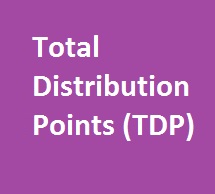ABOUT RETAIL AUDIT


Brand Distribution and Average Number of SKU are complementing each other KPIs. Brand Distribution reflects the distribution breadth (horizontal development) while Average Number of SKU demonstrates distribution depth (vertical development).
TDP (Total Distribution Points) is summarizing measure that takes into account both breadth and depth of distribution and calculated as Brand distribution multiplied by Average # of SKU.
We also can use a bit different way to calculate TDP based on our Retail Audit database, for this purpose we need to sum up Distribution of all SKUs of the Brand.
Example:
| Distribution | |
|---|---|
| Brand Х | 90% |
| Product Х 1liter PET | 80% |
| Product Х 2liters PET | 70% |
| Product Х 0,33liter GLASS | 30% |
Total Distribution Points (TDP) of Brand X = 80% + 70% + 30%= 180%
Distribution of Brand X = 90%
Average # of SKU of Brand Х =(80% + 70% + 30%)/90% =180%/90% = 2
There are many examples of how this measure can be used:
First of all, it is recommended to use this measure as main KPI for the sales team. It will to ensure that team will not forget to maintain distribution in existing outlets while building distribution in new outlets
Nevertheless, TDP can be used not for the team motivation only.TDP can also be used as alternative to shelf share during negotiations with retailers (in the eyes of retailers Retail Audit/Syndicated data is more reliable source of information than producer’s internal data). For this purpose, you should start with calculation of such KPI as Sales per TDP point.
1. Calculation of sales per distribution point to define the most attractive products
Example:
| Sales Items | TDP | Sales Items/TPD | |
|---|---|---|---|
| Brand A | 30 000 | 50 | 600 |
| Brand B | 75 000 | 90 | 833,3 |
| Brand C | 141 000 | 107 | 1 317,8 |
| Brand D | 35 600 | 60 | 593,3 |
| Category | 281 600 | 307 | 917,3 |
In our example, Brand C is the most attractive for new listing/ portfolio expansion as it has biggest sales per point of TDP distribution.
2. Analysis of brands effectiveness and their roles in portfolio through Brand Productivity index
Example:
| Sales Value, $ | Sales Items | TDP | |
|---|---|---|---|
| Brand A | 1 200 000 | 30 000 | 50 |
| Brand B | 3 750 000 | 75 000 | 90 |
| Brand C | 2 820 000 | 141 000 | 107 |
| Brand D | 356 000 | 35 600 | 60 |
| Category | 8 126 000 | 281 600 | 307 |
Let’s calculate share for each measure.
| Value Share | Items Share | TDP Share | |
|---|---|---|---|
| Brand A | 14,8% | 10,7% | 16,3% |
| Brand B | 46,1% | 26,6% | 29,3% |
| Brand C | 34,7% | 50,1% | 34,9% |
| Brand D | 4,4% | 12,6% | 19,5% |
| Category | 100% | 100% | 100% |
Based on the above we calculate a Productivity Index for Value and Items.
Value Productivity Index = Value Share / TDP Share
For example, Brand A has the following Value Productivity Index = 14,8%/16,3% = 0,91
| Value Share | Items Share | TDP Share | Productivity Index, Value | Productivity Index, Items | |
|---|---|---|---|---|---|
| Brand A | 14,8% | 10,7% | 16,3% | 0,91 | 0,65 |
| Brand B | 46,1% | 26,6% | 29,3% | 1,57 | 0,91 |
| Brand C | 34,7% | 50,1% | 34,9% | 1,00 | 1,44 |
| Brand D | 4,4% | 12,6% | 19,5% | 0,22 | 0,65 |
| Category | 100% | 100% | 100% | 1 | 1 |
Brand B is a great premium brand that has a large consumer demand and it is the most effective brand in this category in terms of Sales Value.
Brand C is quite interesting as well, it isn’t so efficient in terms of Sales Value as Brand B, but more interesting in terms of Sales Items as it drives consumer traffic.
Brand A and Brand D are potentially not interesting and should be considered as candidates for portfolio cut.